Microsoft BUILD: Windows 8, A Pre-Beta Preview
by Brian Klug & Ryan Smith on September 13, 2011 12:05 PM EST- Posted in
- BUILD
- Windows
- Microsoft
- Windows 8
- Trade Shows
The Metro UI
The best way to describe Windows 8 is a cross between the Metro UI from Window Phone 7 and the desktop architecture of Windows 7. In fact, virtually everything but the desktop gets a Metro treatment in Windows 8.
The Windows home screen starts initially hidden behind a lock screen virtually identical to WP7’s - slide up on a large edge-to-edge background to unlock. Inside is the Metro start screen, which is comprised of a grid of live application tiles that behave almost identically to those in Windows Phone 7. Two sizes of tiles serve as both application launch shortcuts and notification areas that can be populated with notifications, graphics, and other status indicators.
The tiles populate a horizontal strip that can be scrolled back and forth, and tiles can be rearranged accordingly. There are a few new gestures here over what we’ve seen before in WP7, including a swipe up to select a tile, and multitouch scrolling plus tile repositioning. Swipe up on tiles, and you can select them to convert size, uninstall, or unpin from the home screen.
The new start menu is more than a user experience oriented at tablets, it’s also the design language Microsoft has adopted for the entire new Windows 8 experience.
The thing to realize is that this modality isn’t so much a view as it is a combination of both new start menu, new interface for making Windows usable from a mobile perspective, and a completely new interaction paradigm. The interface is designed to perform and behave in the same way across multitouch, active digitizer, and keyboard+mouse combinations.
There’s another set of gestures and features as well which make use of the four edges of the display. The top and bottom are reserved for application-specific functions, the left and right are reserved for two Windows 8 specific tasks.
Sliding one’s finger from the left edge onto the display allows for both fast application changes, and the multiple-window snap functionality that’s been demoed already. The split is roughly 1:4 and divides horizontal real-estate between two applications views at once. The narrower of the two requires some additional development support, but the aim is to create a workable touch interface without sacrificing multitasking.
Swiping a finger from the right edge of the display towards the center brings up what Microsoft calls charms. This is a view that includes status indicators, and functionality like search, share, start, devices, and settings.
These respective shortcuts then bring up panes that occupy the same area on the right, and do what you’d expect. Settings for example is a place each application to build out a preferences area, so that each application has a common place users will go to control things.
Likewise, share acts like an intelligent copy paste, sharing working elements between applications. Finally search can either look through files and applications or dive into strings surfaced by other third-party applications.
These left and right based gestures exist across not just the Metro-infused start screen, but the entirety of Windows.
Moving around and getting back to the home screen is accomplished by pressing the Windows button, which on the tablet we were loaned is its own physical button analogous to iOS’ home button. Pressing the keyboard windows button performs the exact same action and summons the start menu.
The current set of first-party applications is pretty spartan. There’s no maps, mail, or camera application, though Microsoft has already bundled a set of its own internally-created applications. These are entirely Metro themed as well. I mention camera because the sample hardware includes a front facing and rear facing camera, and at present the only way to access them is through the change user tile picture function, which can capture a photo from the front or back webcam.
Throughout the entire OS is a very WP7-like virtual keyboard, which supports a full size and thumb keyboard mode. There’s also a handwriting recognition mode which has two lines of handwriting input and is styled similarly to Windows 7’s tablet input keyboard.
The keyboard can be docked to the bottom of the display or detached and dragged around as well. I find that the split keyboard accommodates typing with thumbs and holding the device midair quite well.


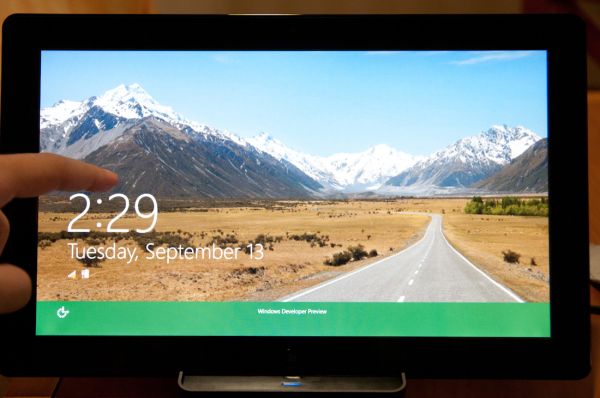
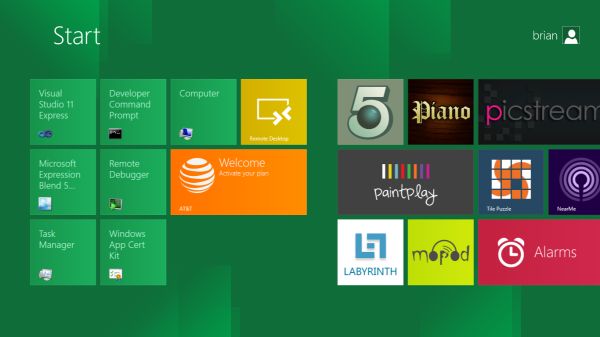
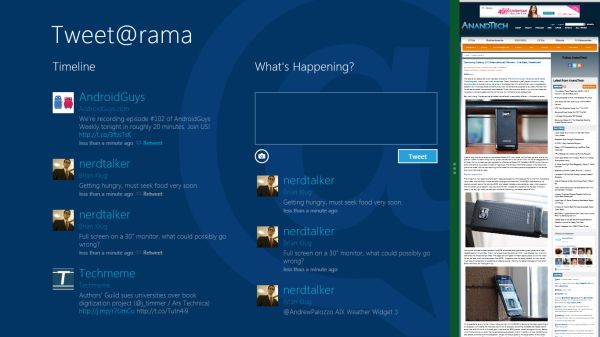
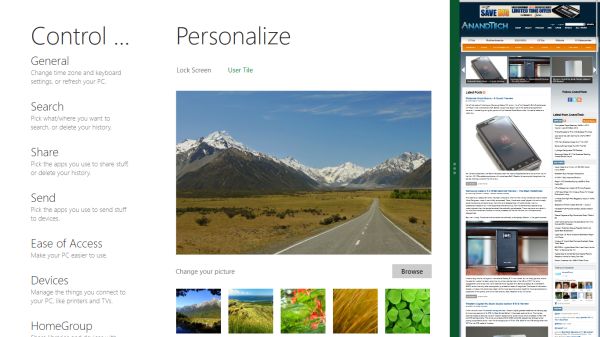

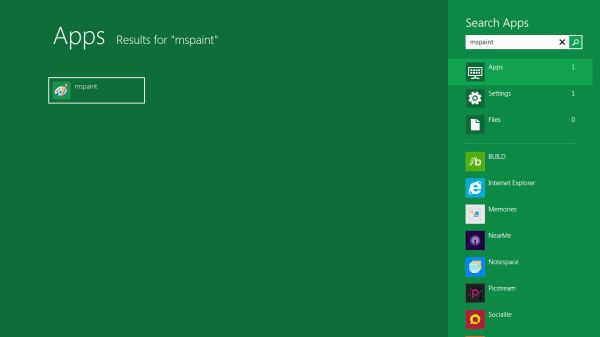
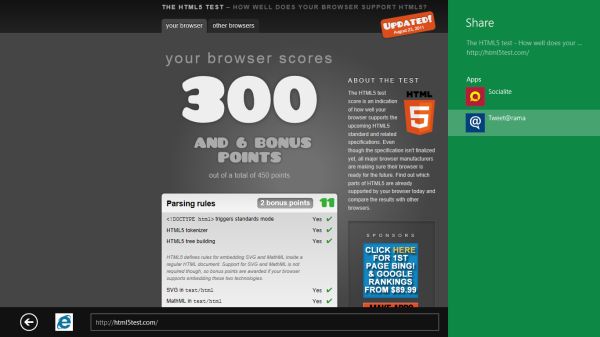
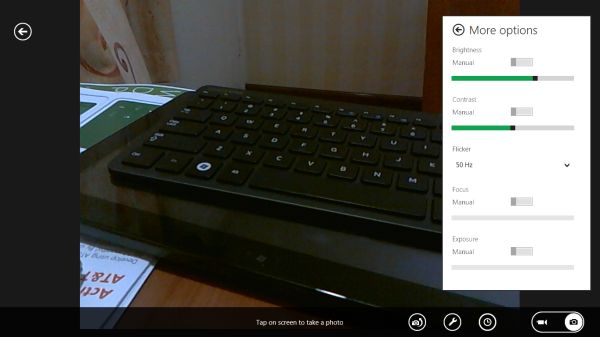
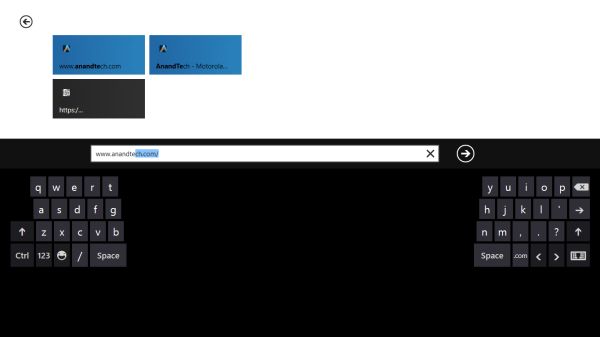








235 Comments
View All Comments
broccauley - Wednesday, September 14, 2011 - link
actually, if you connect a mouse to Android a cursor will appear.faizoff - Tuesday, September 13, 2011 - link
Wonder when the Beta release will be to the public.KPOM - Tuesday, September 13, 2011 - link
From what I've seen so far, Windows 8 looks very promising. For those who are skeptical of the Metro UI in the enterprise, consider that Apple is making inroads into the Enterprise market with the iPad. Companies are issuing them to executives and traveling professionals to keep up with e-mail and log into their intranets. A Windows 8 tablet or Ultrabook might allow them to have a single device for everything.sviola - Tuesday, September 13, 2011 - link
Agreed. And it will probably have much less resistance from the IT department as well.sticks435 - Tuesday, September 13, 2011 - link
That may work for non-tech people, but it won't fly at any IT related company. I hardly doubt they are going to make SQL Developer, Apache directory studio, Eclipse or any dev related apps for Metro.KPOM - Tuesday, September 13, 2011 - link
From what I've seen so far, Windows 8 looks very promising. For those who are skeptical of the Metro UI in the enterprise, consider that Apple is making inroads into the Enterprise market with the iPad. Companies are issuing them to executives and traveling professionals to keep up with e-mail and log into their intranets. A Windows 8 tablet or Ultrabook might allow them to have a single device for everything.trip1ex - Tuesday, September 13, 2011 - link
That dream will not happen. Tablets that can actually run Win8 will be too hot, and heavy with crappy battery life to make a good tablet so then why bother?UMADBRO - Tuesday, September 13, 2011 - link
Because obviously, you have leaped into the future, got a finished version of Windows 8, finalized and production quality hardware, and have completely ran it through its paces. Thank you, sir, for the future insight. No more questions remain. PRAISE Trip1ex!ph0tek - Wednesday, September 14, 2011 - link
You're a moron.Decaff - Tuesday, September 13, 2011 - link
First of all, thanks for a great article which covered alot of the things we can expect in Windows 8 (or whatever the final name will be).Now, I'm left to wonder about a few things. One issue that springs to mind is that MSE now appears to be integrated into the OS to some extent. How will this upset the AV vendors, and how does it affect corporate users who can currently only use MSE if they have up to 10 machines?
Now, that was mostly a technicality. It is mentioned in the article that you can pinch to zoom on the start-screen, and the tiles would change size and adapt. Wouldn't this make it somewhat more effecient to use a mouse and a keyboard? Also, wouldn't it be a simple fix to allow the mouse-wheel to scroll left and right in the tiles display? Down goes left and up goes right?
Personally, I am also very interested in seeing how the metro UI will handle file organisation. I can definately see the alure of using the metro ui to browse my files, but how will it handle renaming and moving of files when I try to organise files belonging to different programs (i'm a university student, so I keep .pdf .docx, pictures and other types huddled together for projects). Typically, touch interfaces have done away with the traditional folder structure and instead used the relevant program to access the file structure (i.e. want to check your PDF, open adobe reader).
I'm also left to wonder whether the Repair function isn't simply a rebadging of the old system restore function, which has existed since XP as far as I recall. That one also left the user's files on the drive, and only looked at installed programs and such. Still, it is nice that they are putting more emphasis on it now, and the "revert to stock" function is becoming to obvious to the user. Hopefully, this will futher eliminate the need for DVD's with backups.
I do think the Metro UI holds some great promises, though not for the hardcore users. There will probably always be a need for a psychical keyboard and mouse in order to perform certain tasks, and I couldn't imagine writing anything serious on an on-screen keyboard. Though just imagine having the metro UI for a tablet, and being able to dock it to a traditional setup with mouse, keyboard and a big monitor and getting some work done. All without the need for extra devices. Or a dock-able keyboard, creating a laptop for the road along the lines of the Asus Transformer.
For me, I think the Metro UI is a great evolution for Windows, towards the current user scenarios, which is that the computer is more quite casually. The great part here is, that even if the connected part will sync all my photos from my phone and whatnot, I will still be able to attach a proper DSLR through a USB port and access all my photos in an instant, something which is hardly possible on most other tablets these days.
Some have mentioned the corporate side of bringing in a new interface, but in reality, do corporations really spend time and actual resources teaching personnel how to use the OS? Historically, corporations have always been very late to adopting new OS'es, which begs the question, whether or not training will really be necessary once people have gotten acquained with the OS privately.
There are still alot of questions that needs to be answered on how Microsoft plans on integrating some of the more mundane tasks into the new UI, and as always, I think their succes will largely be defined by their attention to detail, and ensuring that users can "live" in the Metro UI while still maintaining their productivity or even increasing it.